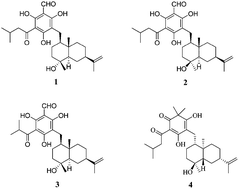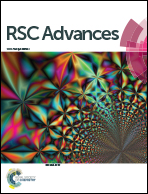Rhodomyrtals A–D, four unusual phloroglucinol-sesquiterpene adducts from Rhodomyrtus psidioides†
Abstract
Four novel compounds, rhodomyrtals A–D (1–4), with two unprecendented carbon frameworks of phloroglucinol coupled eudesmane, together with the known compound eucalyptin A (5) have been isolated from the leaves of the Australian plant Rhodomyrtus psidioides. The structures of compounds 1–4 were elucidated by spectroscopic analysis and ECD calculations. Some of the compounds showed good antibacterial activity against selected Gram-positive strains.


 Please wait while we load your content...
Please wait while we load your content...